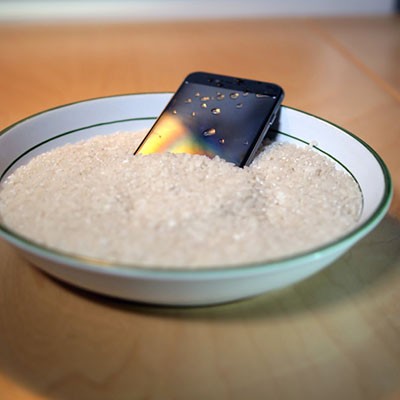EZ MSP Blog
Tip of the Week: What To Do With a Wet Smartphone
Even though no one will admit to it themselves, everyone knows that person that, for some reason or another, has dropped his/her smartphone in the toilet, or into the sink, or into a puddle. Needless to say that dropping electronics into any bit of water isn’t typically recommended, but today we will talk about what to do if this happens to you.
Before we begin we should mention that many smartphone manufacturers are now creating devices that are at least water resistant. These devices are given an IP score. IP stands for International Protection as drawn up by the International Electrotechnical Commission (IEC), which is a classification given to a device that rates the type of protection a consumer should expect. If your device is classified as IP67, it is resistant to dust and can be submerged in water no more than one meter deep for up to a half an hour. The only difference between IP67 and IP68, is that devices that are classified as IP68, guarantees protection in water up to one and a half meters deep for a half hour.
Regardless of how your smartphone is classified, it is probably not a great idea to expose it to water for very long. If it does happen, following these steps will give you the best chance of saving the device.
1. Turn off your device.
If it is off, do not turn it on.
In fact, there are a bunch of things you will not want to do. Don’t plug it in. Don’t shake it. Don’t blow in it. Don’t try and use a blow dryer to save it. In fact, if this happens to you, don’t do anything to the device except the outlined suggestions in this list.
2. Remove your SIM and any expandable storage you have inside your device.
3. If your phone has a battery that can be removed, remove the battery
If you don’t have a phone where you can easily access the battery, don’t just pry it open. Either take it to a professional to do so, or check out the many YouTube tutorials available to properly take your phone apart and remove the battery.
4. Use an absorbent rag to dab your phone dry.
Do not wipe it around as it could spread the liquid to more, harder to reach parts of your phone.
5. Bury the phone in a ziplock bag filled with uncooked rice.
The rice will absorb the liquid.
6. Let your phone dry for a day or two before trying to turn it on.
7. After that time, try turning it on.
If it doesn’t turn on, try charging it. If it doesn’t charge, your battery was probably damaged. At this point you’ll want to take it to a professional if you haven’t done so already.
8. If it seems to work properly, makes sure it does.
If all seems well, you’ll want to test the display for responsiveness, test your speakers and your microphone to makes sure they work properly.
If you follow these eight tips, you may just have a chance to save your (likely expensive) smartphone from the eWaste pile at your local landfill. If you like this tip, return to our blog weekly for more tips and tricks to help you get the most out of your technology.

